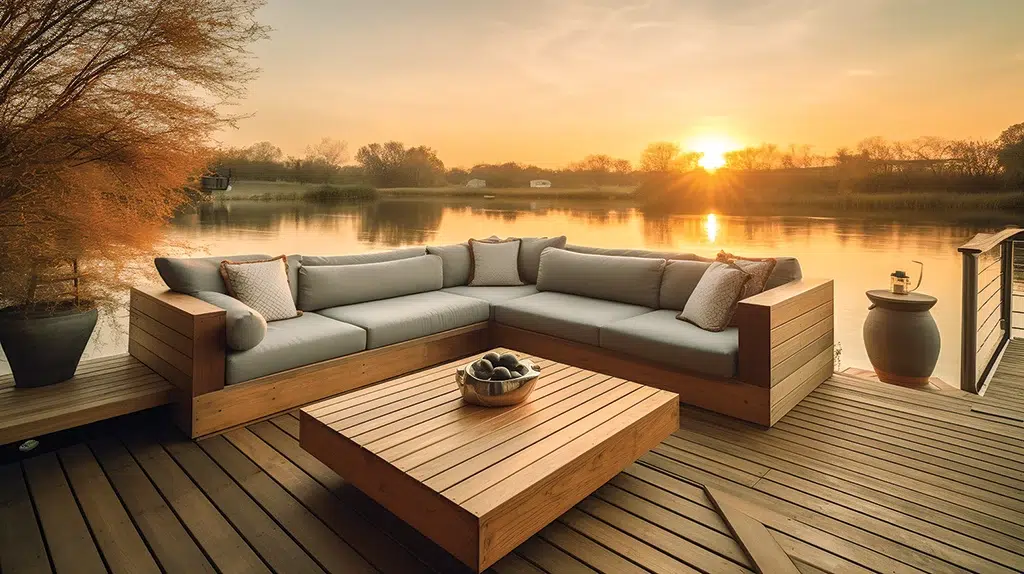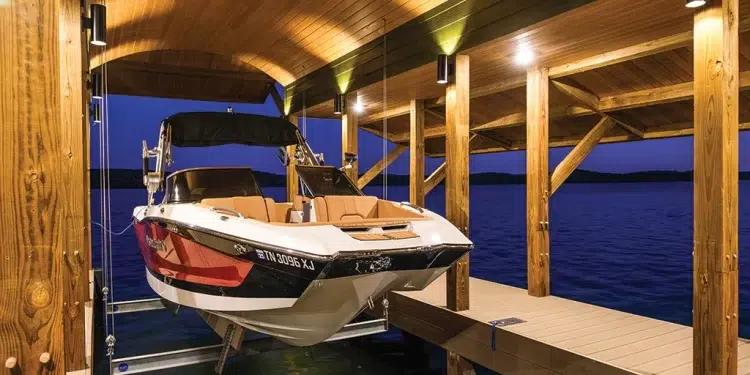Key considerations and must-have features when designing a custom boat dock
Designing a custom boat dock is an exciting endeavor that allows you to create an inviting and functional space for relaxation, entertainment, and enjoyment of the great outdoors. To ensure a successful outcome, it’s important to take various factors into account, such as materials and safety features, and incorporate essentials that align with your specific needs, like seating arrangements and lighting. It also requires careful consideration and planning.
Location and Water Conditions
Choosing the right location for your boat dock and deciding between floating and fixed construction are crucial. Consider water depth, current patterns, and shoreline characteristics. Assess the water conditions throughout the year to account for fluctuating tides, storms, and wave actions. Understanding these factors will guide the construction of a dock that is stable and durable, providing safe and easy access to your boat.
Size and Layout
The size and layout of your custom boat dock design should be tailored to your specific requirements. Consider the number and size of boats you plan to accommodate, as well as the activities you’ll do. A layout with ample space for maneuvering and storage ensures convenience and enhances safety.
“One of the biggest mistakes we see is making the dock or slips too small,” says Daniel Miller, vice president of operations for Chattanooga Dock Builders in Chattanooga, Tennessee.
“Take the LOA of the largest boat you imagine ever using at the dock and add three to four feet to get the slip length. The extra three to four feet allows for some wiggle room so the swim platform or outboard motor aren’t sticking out of the slip. …Don’t forget to take into account head clearance on the dock and make sure your roof is high enough for bimini tops, wakeboard towers, and lights or antennas to clear.”
Material Selection
Choosing the right materials is important for the longevity and maintenance of your custom boat dock. Consider the climate and maintenance requirements when making your selection.
According to the pros at Duncan Seawall, Dock and Boat Lift, LLC, in Sarasota, Florida, the general rule is to pick high-quality and durable materials to build your dock. Typically, pressure-treated wood is one of the most popular options today. However, you can also experiment with other materials that could offer more benefits. These include:
HDPE: High Density Polyethylene (HDPE) is durable and easy to work with since it doesn’t require special tools. HDPE doesn’t absorb water or liquid, meaning it is rot-resistant. This material is best used for the understructure and the actual dock plank.
Aluminum: Aluminum is a lightweight and long-lasting option for dock-building. Its durability and strength are a couple of reasons why aluminum is a popular option.
Wood: Wood can be an affordable option if you are on a budget. Wood is aesthetically pleasing and easy to work with. However, it requires a lot of maintenance, including annual painting, staining, and replacing rotted or warped wood planks.
“Composite decking is perfect for family docks,” adds Matt Greenfield, a writer for Today’s Homeowner who specializes in home improvement projects. “Homeowners won’t need to worry about water damage, scuffing, or splintering. The wide range of color options that come with composite decking can be a real bonus for homeowners who want their dock to match their home.”
Each material has its pros and cons, including durability, cost, aesthetics, and resistance to weather and water-related damage.
As for dock pilings, Miller says depending on the application, site condition, and budget, the preferred materials are composites, treated wood, and steel. “Fiberglass rosin pilings like Fortress pilings are a great corrosion and rot-proof option, but typically cost three to four times as much as wood and twice as much as metal,” he says. “Steel pipes, H-beams, or square tube are more frequently used for spud poles or pilings on floating docks. Wood, due to its buoyancy, is not suitable for spud pole anchoring. Spud poles and pilings can be bare steel or hot-dip galvanized. An engineer should be involved in critical structural applications to determine the corrosive conditions at the site and the appropriate metal coating or corrosion allowance. Keep in mind that protective metal coatings can be scraped off during pile driving installation or from repetitive motion of pile guides or sleeves on floating docks.”

Aesthetics and Personalization
Custom boat dock designs can be an extension of your personal style. Consider the aesthetics of the surrounding environment and choose a design that complements it. Add personalized touches such as seating areas, observation decks, or storage compartments to enhance the overall experience. Choose weather-resistant furniture and place it in an area where your view isn’t obstructed.
Deck lighting is especially important both for aesthetics and safety. Miller recommends motion-activated flood lights with integrated cameras on the corners of the dock to help deter theft. Underwater LED lights can be added for fishing or for that extra wow factor if they are colorful and bright.
“If the dock has a long walkway, it is also advised to install warning lights along the walkway, so boaters don’t try to navigate around the shore side of the warning lights on the dock, thinking it’s another boat, and hit the walkway,” he adds. “Warning lights should be connected to a photocell, so they automatically come on at night. If you incorporate a switch into the warning light wiring, make sure it is clearly marked ‘leave on’ and in an out-of-the-way area so it isn’t accidentally turned off.”
Safety Measures
Speaking of safety, it should be a top priority whencustom designing a boat dock. As well as adequate lighting, other important safety features to incorporate include sturdy handrails and nonslip surfaces. Install bumpers or fenders to protect both the boat and the dock during docking and mooring. Additionally, consider adding ladders or gangways to secure easy access for passengers.
“Keep in mind that docks that are in shallow water may benefit from a safety railing along the walkway to ensure accidental falls into very shallow water close to shore are avoided,” says Greenfield.
Check with your city, county, and state building code authorities for mandatory guidelines regarding dock electrical systems. Electrical shock hazards are one of the major concerns on docks. Keep in mind just because your dock is wired properly there can still be a risk from a neighboring dock or stray current from lines on shore. Miller recommends every dock have a current sensor and alarm device installed.
Incorporate utility options to enhance convenience and functionality. Install power outlets for charging boat batteries and providing electricity for various equipment. Consider adding freshwater lines for cleaning and maintenance purposes. Moreover, ensure accessibility for people with disabilities by integrating ramps or lifts that meet ADA regulations. “Select a high-quality sloped ladder or water stairs, especially if you have guests with physical challenges, elderly, or pets that use the dock,” says Miller.
A well-designed boat dock enhances functionality, safety, and aesthetics. Some may want to take it on as a DIY project, but Miller says when it comes to actually building on the water, it can be a much trickier environment than you would think. “You can’t have your lumber yard just drive up and dump materials on the ground like you can when building a house,” he says. “A professional dock builder will be setup with the knowledge, equipment, and manpower to make your project a success.”
-by Bonnie Schultz
















